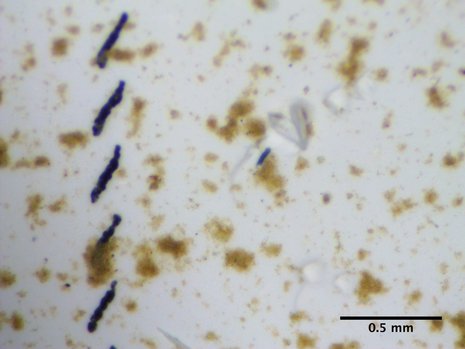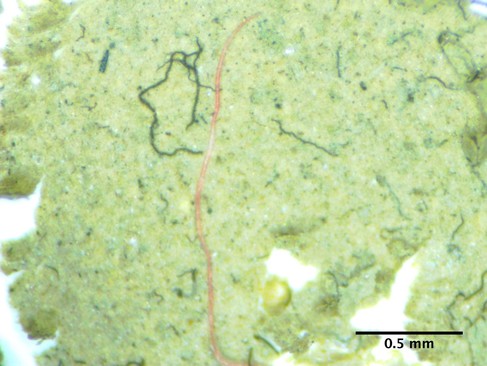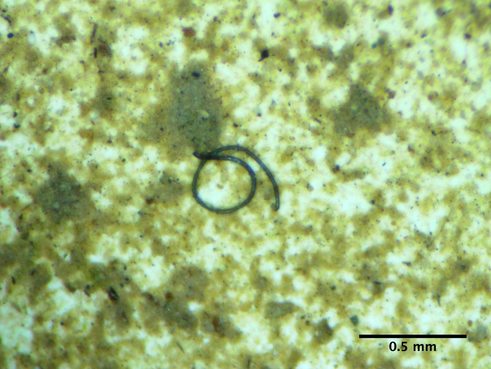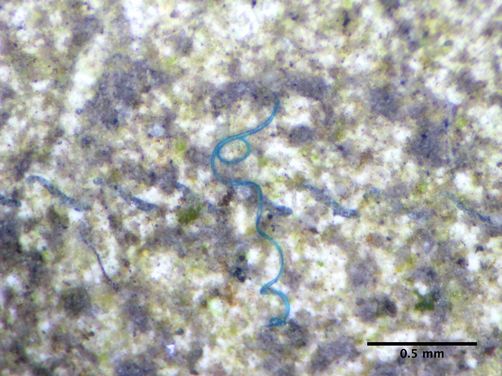Thank you for collecting water samples with the Adventure Scientists’ Worldwide Microplastics Initiative. Your efforts are helping us understand the distribution and concentration of microplastics in the world’s waters, while also building the planet’s largest microplastics dataset. Principal Investigator Abby Barrows has processed your microplastics samples, and we’re excited to share the results of your work!
Lab Process
First, let us briefly explain the process your samples go through in the lab. Once Abby receives your sample, she vacuum pumps each sample over a filter. After the filter has dried, Abby uses a microscope at 45x magnification to look for pieces of microplastic that are less than 5 millimeters. Moving along the grid lines, the filter is systematically counted, with each plastic piece categorized based on shape (round, microfiber, other) and color (blue, red, black, transparent/white, other). The final count for the sample is divided by the sample volume. This calculation helps to standardize the results, as incoming water samples are often not exactly one liter of water.
Project Results
To date, 1731 of 2294 samples analyzed (75%) contained microplastics. 87% of marine samples contained plastic, while 49% of freshwater samples contained plastic. 24,569 pieces of microplastic have been counted. On average, we are finding 9 plastic pieces per liter of water. You can check out the number of pieces per liter in each individual sample on the map on our microplastics page.
Note: In the results listed here, we report the total microplastic pieces found in all of your samples. However, for many of our calculations and for the online map, we report the total pieces per liter. As such, your microplastic total on the map may appear different from your total below.
Also, please let us know if your sample isn’t located in the correct place on the map, so that we can fix it for you.
Expedition-Specific Results
Antipoison Creek
Kathleen Daley and Gary Greenwood
Chesapeake Bay Area, Virginia
Kathleen and Gary collected three samples during their kayak outings in Chesapeake Bay, which contained one blue microfiber. Kathleen is a part-time graduate student at Virginia Tech and part-time environmental analyst in the Chesapeake Bay watershed. Gary is the director of a computer software company. You can learn more about Kathleen’s work to raise awareness about issues the Bay faces at her blog, Beyond the Bay.
Bogdan Bontas and Gabriel Gritcu
Romania
Bogdan and Gabriel are official custodians of the Natura 2000 Protected Area in Romania. They are conducting an ecological monitoring project on five reservoirs—including sampling soil, water, and fish tissue—to determine the heavy metal and microplastic concentrations in the area. Bogdan also works as a Biologist and Project Coordinator, and Gabriel the Head Ranger, at the Regional Center for Ecology. Bogdan collected ten samples, which contained 23 pieces of microplastic: two red fibers, one purple fiber, three blue fibers, two clear films, two black fibers, six blue fragments, and seven blue films.
Rebecca and Tanner Pollock
Ontario, Canada
Rebecca is the communications manager at Georgian Bay Biosphere Reserve. Designated by UNESCO in 2004, the Georgian Bay Biosphere Reserve is an area of 347,000 hectares that stretches 200 km along the eastern coast from Port Severn to the French River, in the world’s largest freshwater archipelago. Rebecca and Tanner (age 6) collected two samples, which contained eight pieces of microplastic: two blue fibers, three clear fibers, and three black fibers. Their expedition in Georgian Bay was part of eXXpedition Great Lakes, the largest simultaneous sampling of microplastics in history. You can read more about eXXpedition Great Lakes 2016 in our Field Notes.
Kayaking the Duck
Ryan Trenkamp and Jaran Miller
Duck River, Tennessee
Ryan and Jaran collected three samples, which contained two black microfibers and one clear fragment, during their kayak trip on the Duck River. Ryan enjoys documenting his hiking and kayaking expeditions through writing, photography and videography. You can check out his work at SkySail Productions.
Maxine Graves, Luke Rosa, Niara Brown, and Grace Freedson
Wrightwood, CA
Maxine is the President and Niara, Luke, and Grace are members of the Environmental Camping club, and they collected samples from creeks surrounding Wrightwood, CA. The team collected two samples which didn’t contain any microplastic.
PCHSECC3.0
Maxine Graves and Luke Rosa
Mammoth, CA
Maxine and Luke collected five samples, which contained three black microfibers, one clear microfiber, and one blue microfiber. Maxine and Luke collected samples in lakes surrounding the Mammoth area during their camping trip.
Smile
Carter Stritch, Shara Derks, Mathew Williams and Anna Williams
Minnesota
Carter, Shara, Mathew, and Anna collected seven samples, which contained two clear microfibers and two blue microfibers. Carter works as a packaging engineer in the Twin Cities area. When not working, Carter enjoys rock and ice climbing, bicycling and canoeing.
Though we’re finding an average of 9 pieces per liter for the project overall, there is much more microplastic in marine samples than freshwater samples. The concentration of microplastic in marine samples is over 13 pieces per liter. This is much greater than the concentration in freshwater samples, which is over 1 piece per liter.
Another interesting trend we’re seeing is 90% of the microplastic we’ve counted is fibrous: the pieces are thread-like or line shaped. Finding a majority of these fibers in samples could suggest that microfibers are the primary microplastic input into waterways.
Thanks so much, again, for your dedication to this program and our shared waterways!




